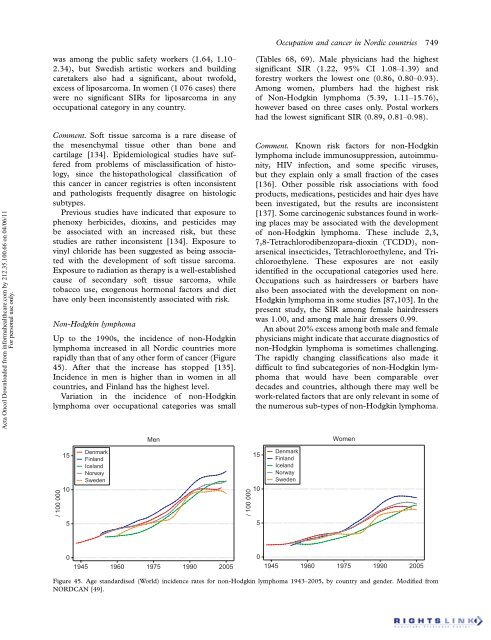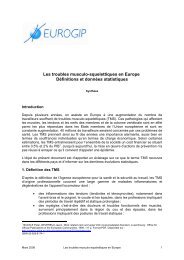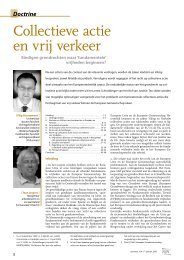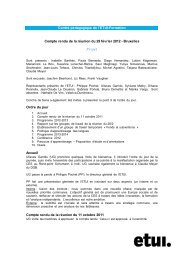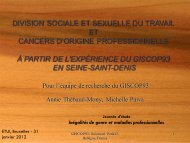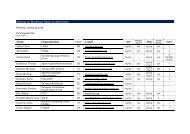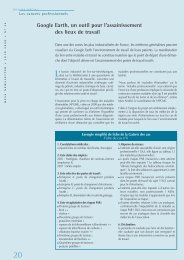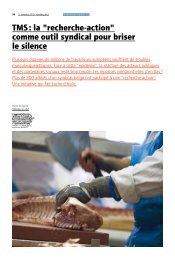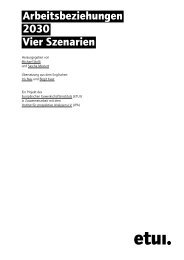Occupation and cancer - European Trade Union Institute (ETUI)
Occupation and cancer - European Trade Union Institute (ETUI)
Occupation and cancer - European Trade Union Institute (ETUI)
You also want an ePaper? Increase the reach of your titles
YUMPU automatically turns print PDFs into web optimized ePapers that Google loves.
Acta Oncol Downloaded from informahealthcare.com by 212.35.100.66 on 04/06/11<br />
For personal use only.<br />
was among the public safety workers (1.64, 1.10<br />
2.34), but Swedish artistic workers <strong>and</strong> building<br />
caretakers also had a significant, about twofold,<br />
excess of liposarcoma. In women (1 076 cases) there<br />
were no significant SIRs for liposarcoma in any<br />
occupational category in any country.<br />
Comment. Soft tissue sarcoma is a rare disease of<br />
the mesenchymal tissue other than bone <strong>and</strong><br />
cartilage [134]. Epidemiological studies have suffered<br />
from problems of misclassification of histology,<br />
since the histopathological classification of<br />
this <strong>cancer</strong> in <strong>cancer</strong> registries is often inconsistent<br />
<strong>and</strong> pathologists frequently disagree on histologic<br />
subtypes.<br />
Previous studies have indicated that exposure to<br />
phenoxy herbicides, dioxins, <strong>and</strong> pesticides may<br />
be associated with an increased risk, but these<br />
studies are rather inconsistent [134]. Exposure to<br />
vinyl chloride has been suggested as being associated<br />
with the development of soft tissue sarcoma.<br />
Exposure to radiation as therapy is a well-established<br />
cause of secondary soft tissue sarcoma, while<br />
tobacco use, exogenous hormonal factors <strong>and</strong> diet<br />
have only been inconsistently associated with risk.<br />
Non-Hodgkin lymphoma<br />
Up to the 1990s, the incidence of non-Hodgkin<br />
lymphoma increased in all Nordic countries more<br />
rapidly than that of any other form of <strong>cancer</strong> (Figure<br />
45). After that the increase has stopped [135].<br />
Incidence in men is higher than in women in all<br />
countries, <strong>and</strong> Finl<strong>and</strong> has the highest level.<br />
Variation in the incidence of non-Hodgkin<br />
lymphoma over occupational categories was small<br />
/ 100 000<br />
15<br />
10<br />
5<br />
0<br />
Denmark<br />
Finl<strong>and</strong><br />
Icel<strong>and</strong><br />
Norway<br />
Sweden<br />
Men<br />
1945 1960 1975 1990 2005<br />
/ 100 000<br />
(Tables 68, 69). Male physicians had the highest<br />
significant SIR (1.22, 95% CI 1.08 1.39) <strong>and</strong><br />
forestry workers the lowest one (0.86, 0.80 0.93).<br />
Among women, plumbers had the highest risk<br />
of Non-Hodgkin lymphoma (5.39, 1.11 15.76),<br />
however based on three cases only. Postal workers<br />
had the lowest significant SIR (0.89, 0.81 0.98).<br />
Comment. Known risk factors for non-Hodgkin<br />
lymphoma include immunosuppression, autoimmunity,<br />
HIV infection, <strong>and</strong> some specific viruses,<br />
but they explain only a small fraction of the cases<br />
[136]. Other possible risk associations with food<br />
products, medications, pesticides <strong>and</strong> hair dyes have<br />
been investigated, but the results are inconsistent<br />
[137]. Some carcinogenic substances found in working<br />
places may be associated with the development<br />
of non-Hodgkin lymphoma. These include 2,3,<br />
7,8-Tetrachlorodibenzopara-dioxin (TCDD), nonarsenical<br />
insecticides, Tetrachloroethylene, <strong>and</strong> Trichloroethylene.<br />
These exposures are not easily<br />
identified in the occupational categories used here.<br />
<strong>Occupation</strong>s such as hairdressers or barbers have<br />
also been associated with the development on non-<br />
Hodgkin lymphoma in some studies [87,103]. In the<br />
present study, the SIR among female hairdressers<br />
was 1.00, <strong>and</strong> among male hair dressers 0.99.<br />
An about 20% excess among both male <strong>and</strong> female<br />
physicians might indicate that accurate diagnostics of<br />
non-Hodgkin lymphoma is sometimes challenging.<br />
The rapidly changing classifications also made it<br />
difficult to find subcategories of non-Hodgkin lymphoma<br />
that would have been comparable over<br />
decades <strong>and</strong> countries, although there may well be<br />
work-related factors that are only relevant in some of<br />
the numerous sub-types of non-Hodgkin lymphoma.<br />
15<br />
10<br />
5<br />
0<br />
<strong>Occupation</strong> <strong>and</strong> <strong>cancer</strong> in Nordic countries 749<br />
Denmark<br />
Finl<strong>and</strong><br />
Icel<strong>and</strong><br />
Norway<br />
Sweden<br />
Women<br />
1945 1960 1975 1990 2005<br />
Figure 45. Age st<strong>and</strong>ardised (World) incidence rates for non-Hodgkin lymphoma 1943 2005, by country <strong>and</strong> gender. Modified from<br />
NORDCAN [49].


